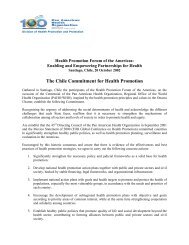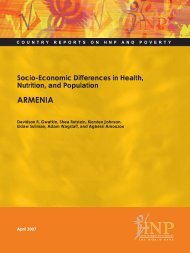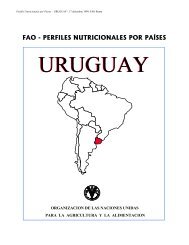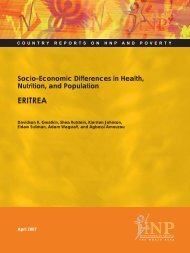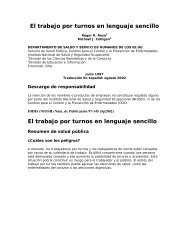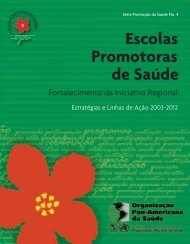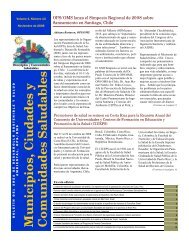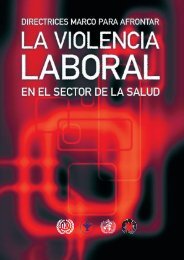Guidelines for drinking-water quality. Volume 1 - BVSDE
Guidelines for drinking-water quality. Volume 1 - BVSDE
Guidelines for drinking-water quality. Volume 1 - BVSDE
You also want an ePaper? Increase the reach of your titles
YUMPU automatically turns print PDFs into web optimized ePapers that Google loves.
organisms” refers to Gram-negative, rod-shaped bacteria capable of growth in the presence of<br />
bile salts or other surface-active agents with similar growth-inhibiting properties and able to<br />
ferment lactose at 35-37 °C with the production of acid, gas, and aldehyde within 24-48 hours.<br />
They are also oxidase-negarive and non-spore-<strong>for</strong>ming. By definition, coli<strong>for</strong>m bacteria display -<br />
galactosidase activity.<br />
Traditionally, coli<strong>for</strong>m bacteria were regarded as belonging to the genera Escherichia,<br />
Citrobacter, Enterobacter, and Klebsiella. However, as defined by modern taxonomical methods,<br />
the group is heterogeneous. It includes lactose-fermenting bacteria, such as Enterobacter<br />
cloacae and Citrobacter freundii, that can be found both in faeces and the environment (nutrientrich<br />
<strong>water</strong>s, soil, decaying plant material), and also in <strong>drinking</strong>-<strong>water</strong> with relatively high<br />
concentrations of nutrients, as well as species that are rarely, if ever, found in faeces and may<br />
multiply in relatively good <strong>quality</strong> <strong>drinking</strong>-<strong>water</strong>s, <strong>for</strong> example, Serratia fonticola, Rahnella<br />
aquatilis, and Buttiauxella agrestis.<br />
The existence both of non-faecal bacteria that fit the definitions of coli<strong>for</strong>m bacteria and of<br />
lactose-negative coli<strong>for</strong>m bacteria limits the applicability of this group as an indicator of faecal<br />
pollution. Coli<strong>for</strong>m bacteria should not be detectable in treated <strong>water</strong> supplies and, if found,<br />
suggest inadequate treatment, post-treatment contamination, or excessive nutrients. The coli<strong>for</strong>m<br />
test can there<strong>for</strong>e be used as an indicator of treatment efficiency and of the integrity of the<br />
distribution system. Although coli<strong>for</strong>m organisms may not always be directly related to the<br />
presence of faecal contamination or pathogens in <strong>drinking</strong>-<strong>water</strong>, the coli<strong>for</strong>m test is still useful <strong>for</strong><br />
monitoring the microbial <strong>quality</strong> of treated piped <strong>water</strong> supplies. If there is any doubt, especially<br />
when coli<strong>for</strong>m organisms are found in the absence of thermotolerant coli<strong>for</strong>m organisms and E.<br />
coli, identification to the species level or analyses <strong>for</strong> other indicator organisms may be<br />
undertaken to investigate the nature of the contamination. Sanitary inspections will also be<br />
needed.<br />
2.2.4 Faecal streptococci<br />
The term “faecal streptococci” refers to those streptococci generally present in the faeces of<br />
humans and animals. All possess the Lancefield group D antigen. Taxonomically, they belong to<br />
the genera Enterococcus and Streptococcus. The taxonomy of enterococci has recently<br />
undergone important changes, and detailed knowledge of the ecology of many of the new<br />
species is lacking. The genus Enterococcus now includes all streptococci that share certain<br />
biochemical properties and have a wide tolerance of adverse growth conditions. It includes the<br />
species E. avium, E, casseliflavus, E. cecorum, E. durans, E. faecalis, E. faecium, E. gallinarum,<br />
E. hirae, E. malodoratus, E. mundtii, and E. solitarius. Most of these species are of faecal origin<br />
and can generally be regarded as specific indicators of human faecal pollution under many<br />
practical circumstances. They may, however, be isolated from the faeces of animals, and certain<br />
species and subspecies, such as E. casseliflavus, E. faecalis var. liquefaciens, E. malodoratus,<br />
and E. solitarius, occur primarily on plant material.<br />
In the genus Streptococcus, only S. bovis and S. equinus possess the group D antigen and are<br />
members of the faecal streptococcus group. Their sources are mainly animal faeces. Faecal<br />
streptococci rarely multiply in polluted <strong>water</strong>, and they are more persistent than E. coli and<br />
coli<strong>for</strong>m bacteria. Their primary value in <strong>water</strong> <strong>quality</strong> examination is there<strong>for</strong>e as additional<br />
indicators of treatment efficiency. Furthermore, streptococci are highly resistant to drying and may<br />
be valuable <strong>for</strong> routine control after laying new mains or repairs in distribution systems, or <strong>for</strong><br />
detecting pollution by surface run-off to ground or surface <strong>water</strong>s.<br />
2.2.5 Sulfite-reducing clostridia<br />
These are anaerobic, spore-<strong>for</strong>ming organisms, of which the most characteristic, Clostridium<br />
perfringens (C. welchii), is normally present in faeces, although in much smaller numbers than E.<br />
coli. However, they are not exclusively of faecal origin and can be derived from other




